Chelsea knocked out Liverpool of the FA Cup with a 2-0 win at Samford Bridge. That happened to be the second consecutive defeat for Jurgen Klopp’s team, which killed their dream of winning a treble. Chelsea’s balanced performance resulted in keeping a clean sheet, despite Liverpool’s 13 efforts. It was a good night for the Londoners but yet one player’s performance is what drew all the attention. The youngster Billy Gilmour impressed with his mature performance and confidence, being praised by all the fans.
Chelsea’s efforts to dismiss Fabinho from the centre worked out for the most part, although Lampard was forced to make changes and the team couldn’t adjust properly afterwards. As expected, Klopp gave a rest to some of his players, but yet decided to look for a balance between the experienced players and the youngsters, opting for a quite different scheme.
This tactical analysis will look into both teams’ tactics and how Chelsea managed to stop the spirited Liverpool.
Lineups
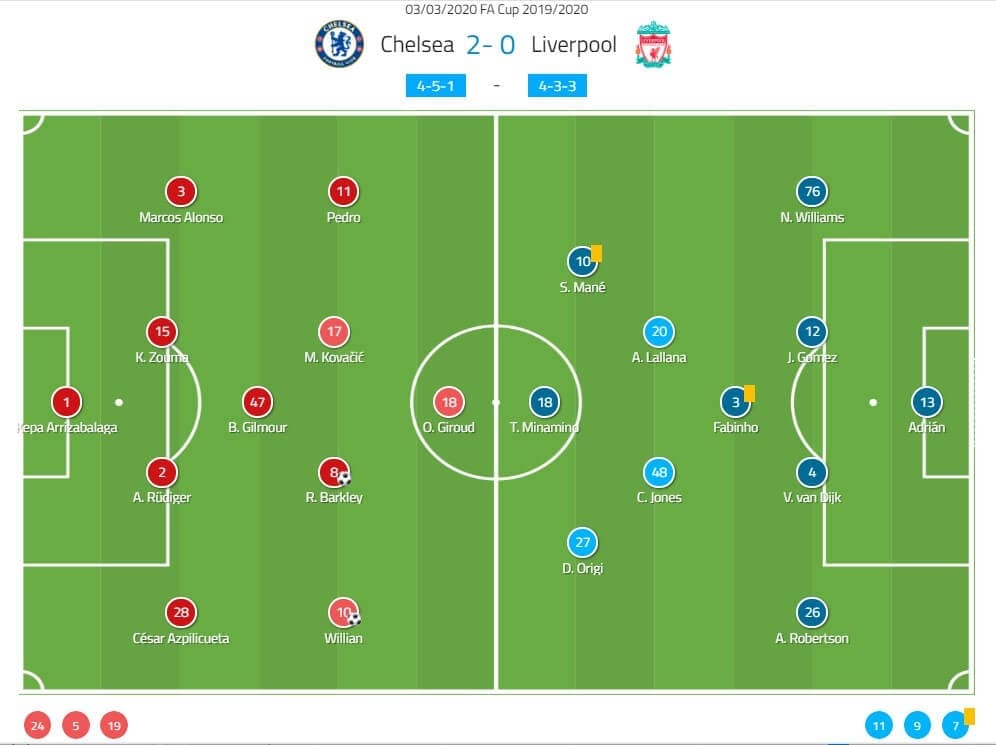
Frank Lampard opted for his regular 4-3-3. Kepa Arrizabalaga covered the goal with the help of Marcos Alonso, Kurt Zouma, Antonio Rüdiger and César Azpilicueta. The midfield was formed by Mateo Kovačić, Billy Gilmour and Ross Barkley, with the youngster having a role in the defensive midfield. Olivier Giroud was positioned at the tip of the attack, supported by Pedro and Willian on the wings.
Jürgen Klopp’s Liverpool played in their 4-3-3 on paper, although they adapted to interesting shapes while attacking. Adrián was at the goal with Andrew Robertson, Virgil van Dijk, Joe Gomez, Neco Williams in the four-man backline. Curtis Jones, Fabinho and Adam Lallana played as a midfield three distributing the ball to Divock Origi, Takumi Minamino and Sadio Mané.
Chelsea’s efforts to bypass Liverpool’s midfield
Chelsea’s main strategy was focused on bypassing Liverpool’s midfield rather than their defensive line since that’s where they met a lot of resistance. Gilmour’s position in the defensive midfield helped the team in retaining possession and providing an additional passing option in their efforts to advance the ball. Chelsea didn’t employ their usual high defensive line, staying conservatively and inviting pressure in their own half. Barkley was responsible for advancing the ball, with the Englishman trying to drag Fabinho with him, opening a space for his team to attack on the right with the help of Willian.
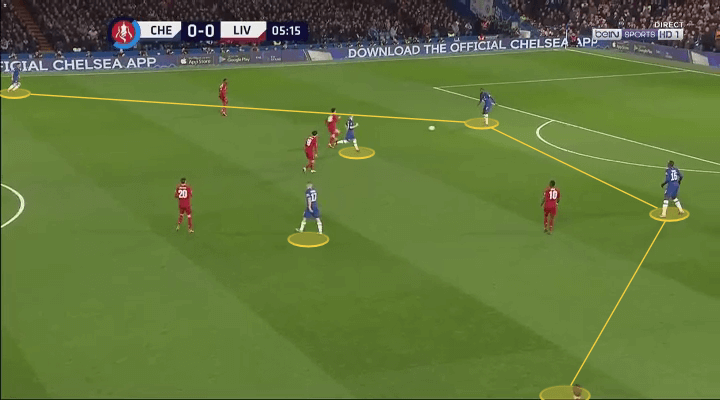
As per usual Alonso’s movement on the left flank was very important due to his positional awareness and rotations with Pedro. Their movement off the ball allowed the team to constantly switch play in order to escape the pressure. That doesn’t mean Alonso neglected his defensive responsibilities. His movement back and forth helped the team in creating counters. Chelsea created eight counter-attacks and four of them ended with shots. Pedro would often be the main man on a counter, due to the freedom Alonso’s movement offered him. He wouldn’t drop too deep to pick up the ball but rather stay in the more advanced areas and wait on a pass.
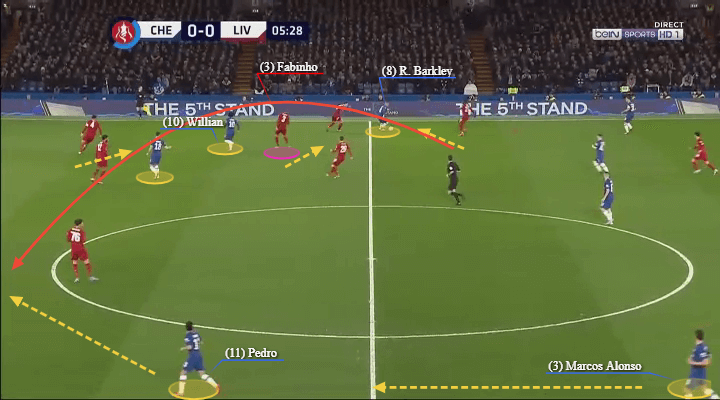
Another threat was Willian, who would constantly occupy the half spaces freed up by Giroud’s movement. The Frenchman would often drop towards the midfield and drag players (most frequently Joe Gomez) with him, leaving opportunities for his teammates.
The changes didn’t work out best
Lampard was forced to do a couple of changes, subbing Kovačić and Willian in favour of Mason Mount and Jorginho. These substitutions didn’t have the expected effect but they were yet enough for the team to cope with Liverpool’s efforts. This meant that there would be positional changes. Mount took over the left-wing, whilst the experienced Pedro moved on the right. Jorginho provided support for Gilmour which should’ve helped the team in both phases. Instead, due to Barkley’s constant aim to go forward and put pressure on Liverpool’s defenders, the two had to cope with the opposition’s full-packed midfield line.
The team’s aggressiveness decreased and their efforts on the flanks lowered, although they took advantage of every chance the Reds’ gave them. Due to them focusing on their attacking actions, Chelsea were allowed to expose the highly positioned defence on a few occasions.
Liverpool’s vulnerability
Liverpool were vulnerable exactly on the flanks which allowed Chelsea to employ their strategy successfully. The lack of experience in some of the players resulted in leaving open spaces which would cause them defensive problems.
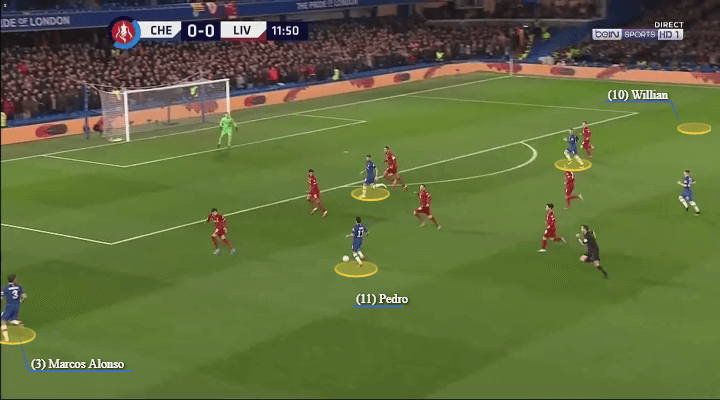
Both full-backs didn’t perform on their potential. Robertson didn’t get the chance to go deep in the opposition half as per usual, whilst the youngster Williams on the other side lacked special awareness and would often leave his defensive responsibilities in efforts to advance. Having Alonso and Pedro against you, whilst leaving gaps behind, immediately means trouble. The team would try to build-up trough the flanks, hence the full-backs, but that would sometimes leave gaps in the centre too.
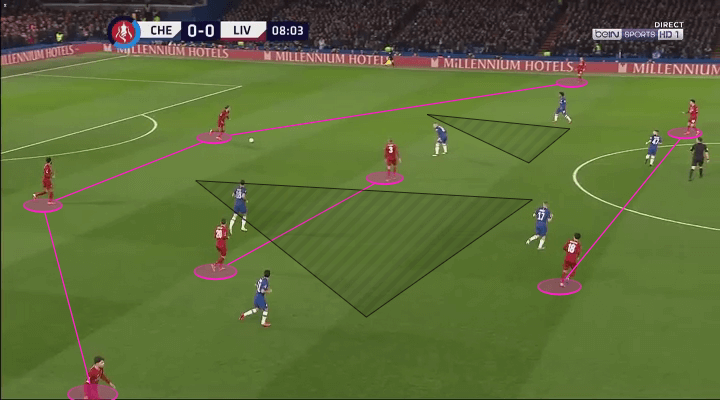
The Reds’ in attack
Liverpool would most frequently try to attack through the right flank. As mentioned Williams would join Lallana and Mané trying to put a lot of pressure on Chelsea’s defenders and take advantage of Alonso’s movement forward. The Blues responded by dropping Kovačić next to the 18-years-old Gilmour and trying to match numbers with their opponents. That, though, gave Liverpool’s midfielders more freedom and they started creating lots of opportunities. As mentioned, Chelsea’s whole team moved deeper into a low-block in efforts to limit the spaces and their opponents’ movement.
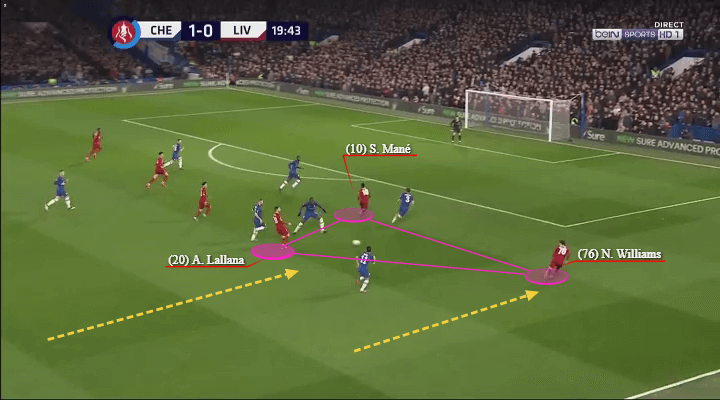
Despite their 4-3-3 out of possession, Liverpool’s shape when attacking was quite different, mostly resulting in Minamino dropping deeper centrally, freeing up space for Origi, who would move around the box and the flank constantly. Liverpool had their chances, but Arrizabalaga’s impressive performance didn’t allow them to capitalise.
Conclusion
Lampard’s analysis of the situation allowed Chelsea to take advantage of their opportunities and expose Liverpool. Despite keeping a clean sheet (thanks to their goalkeeper) it was evident that their defensive struggles continue with no sign of improvement. Should they meet more experienced players their problems would deepen. Klopp on the other side needs to soak in his team’s performance in the last couple of weeks and come up with a solution. It is most likely a temporary drop in performance, but for a team that has to meet such high expectations, this results should not be underestimated.






Comments